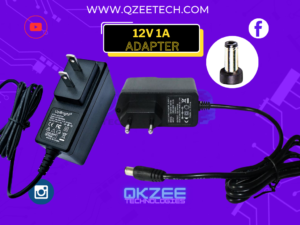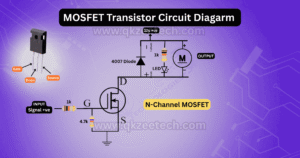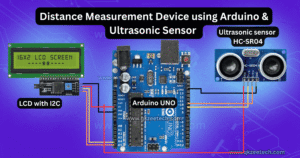How to Use MAX6675 Thermocouple with Arduino for Projects
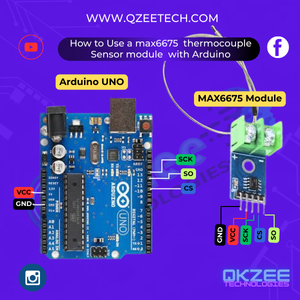
Complete Guide: How to Use MAX6675 Thermocouple with Arduino for Projects
Introduction
Whether you’re working on student projects, final year engineering projects (FYP), or industrial automation, measuring high temperatures accurately is crucial. The MAX6675 thermocouple module paired with an Arduino is a popular, reliable solution for temperature sensing.
This complete guide covers everything from wiring and coding to troubleshooting and real-world applications. Perfect for students, hobbyists, and engineers across Pakistani universities, technical colleges, and DIY enthusiasts looking for a step-by-step tutorial.
If you’re working on student projects, final year engineering projects (FYP), or industrial automation systems, accurately measuring high temperatures is often essential. The MAX6675 thermocouple module paired with an Arduino provides a reliable and cost-effective solution for temperature sensing applications.
This comprehensive guide walks you through everything from wiring connections and Arduino programming to troubleshooting tips and real-world applications. Whether you’re a university student, hobbyist, or professional engineer in Pakistan, this tutorial will help you successfully integrate the MAX6675 into your projects.
What is a MAX6675 Thermocouple Module?
Max5576 is a specialized integrated circuit that converts temperature readings from a K-type thermocouple into a digital signal. It features cold-junction compensation and communicates with microcontrollers via SPI interface, making it ideal for precise temperature measurements.With a measurement range of 0°C to 1024°C and 12-bit resolution, this module is perfect for demanding applications like industrial furnace monitoring, 3D printer temperature control, and scientific experiments. The built-in signal conditioning eliminates the need for additional circuitry, simplifying your project design. The MAX6675 is a cold-junction-compensated K-type thermocouple-to-digital converter. It measures temperatures from 0°C to 1024°C with 12-bit resolution,
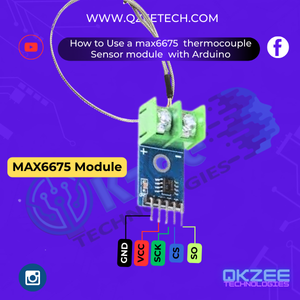
making it ideal for:
-
-
Science projects
-
Engineering projects
-
Industrial automation
-
3D printer temperature control
-
Key Features
MAX6675 offers several advantages that make it popular among engineers and students. Its SPI interface ensures reliable digital communication with Arduino boards, while the cold-junction compensation improves measurement accuracy. The module provides ±2°C accuracy across its entire temperature range.
Additional features include a simple 5V power requirement, compact form factor, and direct thermocouple connection. These characteristics make the MAX6675 particularly suitable for educational projects, industrial applications, and DIY electronics where space and simplicity are important considerations.
✅ SPI Interface – Easy communication with Arduino
✅ Built-in Signal Conditioning – No extra circuitry needed
✅ Wide Temperature Range (0°C to 1024°C)
✅ Accuracy: ±2°C
✅ Digital Output – No analog noise interference
How Does the MAX6675 Work?
The module:
-
-
Reads voltage from the K-type thermocouple
-
Converts it to digital signals using the MAX6675 chip
-
Sends data to Arduino via SPI (Serial Peripheral Interface)
-
Components Required
To get started, you’ll need several basic components. An Arduino Uno or Nano serves as the main controller, while the MAX6675 module handles temperature measurement. A K-type thermocouple probe is essential for actual temperature sensing.
You’ll also need a breadboard and jumper wires for prototyping, and optionally a 16×2 LCD display for showing temperature readings without a computer. These components are readily available at electronics markets like Hall Road Lahore or from suppliers like QKZEE Technologies.
| Component | Purpose | |
|---|---|---|
| Arduino Uno/Nano | Main controller | |
| MAX6675 Module | Thermocouple amplifier | |
| K-Type Thermocouple | Temperature sensor | |
| Breadboard & Jumper Wires | Circuit connections | |
| 16×2 LCD (Optional) | Display temperature | |
| 5V Power Supply | Power Arduino & MAX6675 |
Wiring the MAX6675 with Arduino
Proper wiring is crucial for the MAX6675 to function correctly. Connect the module’s VCC pin to Arduino’s 5V output and GND to ground. The SPI interface requires three connections: SCK to digital pin 13, CS to pin 10, and SO to pin 12.
The thermocouple wires should be inserted into the MAX6675’s terminal block with correct polarity – typically red wire to positive and yellow/black to negative. If adding an LCD, connect it via I2C using Arduino’s analog pins A4 (SDA) and A5 (SCL).

MAX6675 Pinout
| MAX6675 Pin | Arduino Pin |
|---|---|
| VCC | 5V |
| GND | GND |
| SCK | D13 (SCK) |
| CS | D10 (SS) |
| SO | D12 (MISO) |
Step-by-Step Connections
-
-
Power the MAX6675 → Connect VCC to 5V and GND to GND.
-
SPI Communication → Link SCK, CS, and SO to Arduino.
-
Attach Thermocouple → Insert the K-type probe (red = +, black/yellow = –).
-
(Optional) Add LCD → For real-time display:
-
I2C LCD: SDA → A4, SCL → A5
-
-
Arduino Code for MAX6675
Programming the Arduino to read MAX6675 data is straightforward. First, install the MAX6675 library in the Arduino IDE. The code initializes the SPI communication and continuously reads temperature values in Celsius and Fahrenheit.
The example sketch provided demonstrates basic functionality, printing temperature readings to the serial monitor every second. You can easily modify this code to add features like LCD output, temperature logging, or control logic for your specific application.
Required Libraries
Install the MAX6675 library (Adafruit or similar) via Arduino IDE.
Sample Code (Basic Temperature Reading)
#include "max6675.h"
// Define MAX6675 pins
int thermoDO = 12; // SO
int thermoCS = 10; // CS
int thermoCLK = 13; // SCK
MAX6675 thermocouple(thermoCLK, thermoCS, thermoDO);
void setup() {
Serial.begin(9600);
delay(500); // Stabilize MAX6675
}
void loop() {
float tempC = thermocouple.readCelsius();
float tempF = thermocouple.readFahrenheit();
Serial.print("Temperature: ");
Serial.print(tempC);
Serial.print("°C | ");
Serial.print(tempF);
Serial.println("°F");
delay(1000); // Update every second
}
Expected Serial Monitor Output
MAX6675 Test
Temperature: 45.36 °C
Temperature: 102.75 °C
Testing & Troubleshooting
After uploading the code, open the serial monitor to verify temperature readings. Common issues include incorrect wiring (especially SPI connections), poor thermocouple contact, or electrical interference.If readings appear unstable, check all connections and ensure the thermocouple is properly seated. The module may return 0°C if communication fails, indicating potential wiring problems or library issues. Proper grounding and avoiding nearby high-current devices can improve measurement stability.
Step-by-Step Testing
-
-
Upload the code to Arduino.
-
Open Serial Monitor (Ctrl+Shift+M, 9600 baud).
-
Check readings – Should display live temperature.
-
Common Issues & Fixes
| Problem | Solution |
|---|---|
| No reading (0.00°C) | Check wiring (SCK, CS, SO) |
| Incorrect temperature | Verify thermocouple polarity |
| Module overheating | Don’t exceed 5V on VCC |
| Fluctuating values | Keep away from electrical noise |
Applications in Real Projects
The MAX6675 finds use in numerous real-world applications. Engineering students frequently incorporate it into final year projects like smart kilns or temperature-controlled systems. Industrial applications include furnace monitoring, food processing equipment, and HVAC systems. Hobbyists use it for 3D printer hotend monitoring, DIY reflow ovens, and scientific experiments. Its wide temperature range and digital output make it versatile for both educational and professional temperature measurement needs.
-
-
🔥 Industrial Automation – Furnace monitoring, heat treatment systems
-
🎓 Student Projects – Science fairs, university FYPs
-
🏭 DIY Electronics – 3D printers, soldering stations
-
🏫 School Projects – Smart heating systems
-
For FYP assistance in Lahore, check QKZEE Tech, Hall Road, Lahore, or Qasim Shahzad’s engineering services.
Conclusion
The MAX6675 thermocouple module is perfect for high-temperature sensing with Arduino. Whether you’re a student, engineer, or hobbyist, this guide helps integrate it into automation, FYPs, or industrial systems.
For components & engineering services in Lahore:
-
-
Visit Hall Road, Lahore
-
Contact QKZEE Tech / Qasim Shahzad
-
Explore QKZEE Technologies for Arduino kits
-
Where to Buy Your Electronics Components
Looking for affordable components for this Arduino project? Check out QKZee Technologies, an online shop in Lahore, Pakistan, offering the best components for students and DIY projects. Whether you’re looking for sensors, modules, or other electronics at a cheap price, they’ve got it all. Visit them at QKZeeTech.
Can I use MAX6675 with 3.3V boards like ESP32?
Yes! Just power it with 3.3V instead of 5V.
Why is my temperature reading incorrect?
Loose thermocouple connection
Electrical interference
MAX6675 vs. MAX31855 – Which is better?
MAX6675 → K-type only, 12-bit resolution
MAX31855 → Multiple thermocouples, 14-bit (more accurate)
Can it measure below 0°C?
No, only 0°C to 1024°C. Use DS18B20 for sub-zero temps.
Where to buy MAX6675 in Lahore?
visit Hall Road Lahore, or contact QKZee Technologies for genuine parts and student-friendly prices

